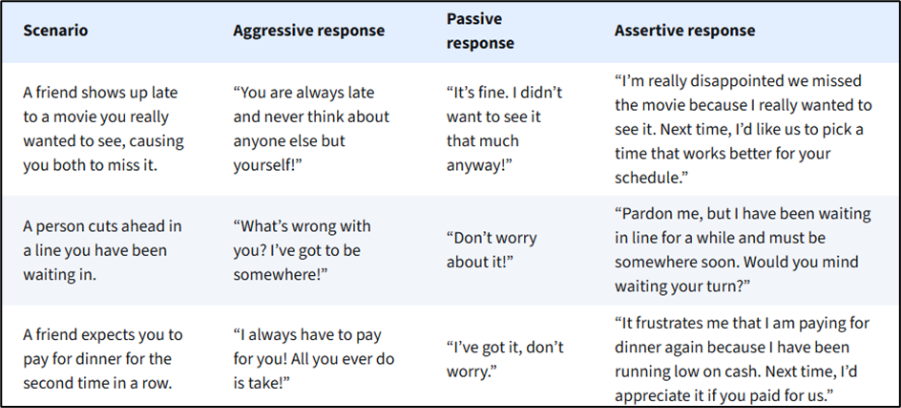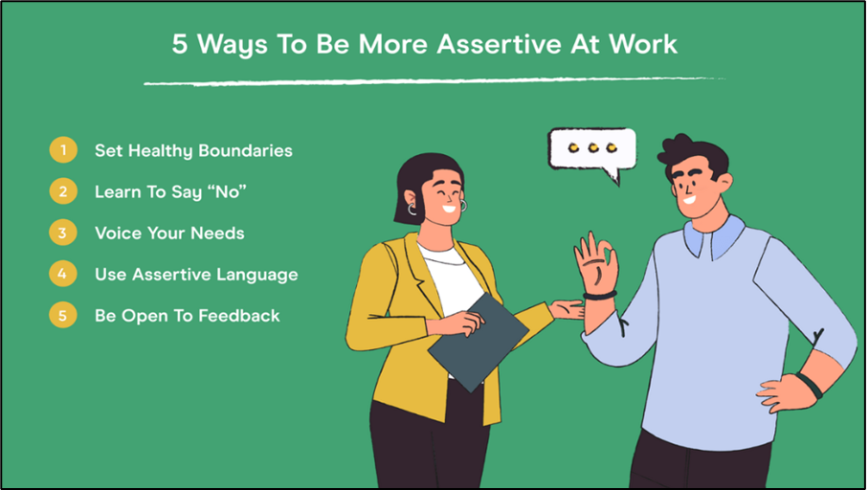Workplace Communication
Assertive Communication: Definition, Benefits, Techniques & Application in Indian Workplaces

.png)
Written by
Aarohi Parakh,
Psychologist and Content Writer

Reviewed by
Sanjana Sivaram,
Psychologist and Clinical Content Head

Introduction
Think about this! Anand, a project manager at a busy Bengaluru office, faces an all-too-common dilemma: his supervisor assigns yet another urgent task, pushing his already full schedule to its limits. Instead of silently accepting or reacting defensively, he calmly says, “I’d love to help, but I’m already managing multiple tasks. Can we prioritise what’s most urgent?” His assertive yet respectful communication leads to a productive conversation, allowing him to reprioritise tasks and lower his stress levels. This scenario highlights the power of assertive communication— expressing one’s point of view clearly and respectfully while considering others. In Indian workplaces, where indirect communication styles often prevail, mastering assertiveness enhances personal effectiveness, supports mental well-being, and fosters a stronger workplace culture. It benefits both employees and leaders: individuals gain confidence and clarity, while managers and HR professionals cultivate engagement, reduce misunderstandings, and strengthen team performance. This blog explores the definition, benefits, techniques, step-by-step approach, pitfalls, and practical application of assertive communication in Indian workplaces.
What is Assertive Communication?
Definition
Assertive communication is a style where individuals express their thoughts, feelings, and needs openly and respectfully, without being passive or aggressive. It allows professionals to advocate for themselves while considering others' rights and feelings, fostering clarity and mutual respect.
Assertive communication, however, can often be confused with passive or aggressive behaviour. This section will help professionals understand the distinctions that enable effective communication in diverse workplace scenarios.
The Communication Styles Spectrum
Communication can be understood along a spectrum, with three primary styles. To see how these differ, visualise a scenario where an employee has an idea during a team meeting, but the manager is moving quickly through the agenda.
- Passive Communication: The employee stays quiet, thinking, “Maybe my idea isn’t important.” The team misses a valuable contribution, and the employee feels overlooked.
Key point: Individuals prioritise others’ needs over personal expression, often causing frustration.
- Aggressive Communication: The employee interrupts the manager: “Let me explain my idea, and why it’s the best approach”. While the idea gets attention, the delivery creates tension.
Key point: Individuals prioritise their own needs over others’, risking conflicts and strained relationships.
- Assertive Communication: The employee waits for a pause and says, “I’d like to add a quick idea that might support what’s being discussed.” Confidence and courtesy ensure the idea is heard without disruption.
Key point: Individuals balance self-expression with empathy, finding a middle ground between passive and aggressive styles without slipping into passive-aggressiveness.
Both employees and leaders benefit from adapting to this approach—it strengthens trust, accountability, and workplace harmony.

The 3 Cs Framework
The 3 Cs—Clear, Consistent, and Courteous—offer a practical guide to assertive communication:
- Clear: Communicating messages unambiguously and with clarity.
- Consistent: Aligning your words and actions builds credibility.
- Courteous: Respecting others’ opinions, which helps create positive workplace relationships.
Applying the 3 Cs enhances clarity, reduces misunderstandings, and strengthens relationships while maintaining respect, critical for both individual contributors and organisational leaders.
Why It Pays Reward (Benefits of Assertiveness)
Being assertive is widely recognised as a healthier and more effective communication style in the workplace. This section lists down several proven benefits that assertive communication offers to individuals and organisations alike:
- Gaining self-confidence and self-esteem: Employees who voice their ideas demonstrate competence. A software engineer proposing an efficient workflow gains recognition, reinforcing confidence. For managers, modelling assertiveness establishes credibility and inspires team trust.
- Gaining a sense of empowerment: Setting boundaries allows employees to manage tasks without guilt. In a call centre, politely declining extra shifts while explaining current commitments maintains workload balance and prevents burnout. Leaders can use this skill to delegate effectively without micromanaging.
- Understanding and recognising feelings: Self-awareness is fostered by assertiveness. When an HR executive observes recurring scheduling conflicts, they can voice their concerns constructively, thereby reducing stress levels. Similarly, managers can proactively address issues related to team morale.
- Earning respect from others: Clear, respectful communication fosters credibility. A sales associate who openly manages client expectations gains trust, while managers earn respect by listening to team input and opinions before finalising decisions.
- Greater self-awareness: Employees understand their feelings and reactions, enabling them to respond thoughtfully. For instance, a team member who identifies their workload stress can communicate their concerns constructively.
- Improved communication and creation of win-win situations: Assertive employees negotiate effectively, benefiting themselves and their teams. Project leads discussing realistic deadlines ensure successful project delivery without overburdening team members.
- Enhanced relationships and decision-making: To improve cooperation, share ideas confidently and solicit feedback. When a marketing expert provides input in brainstorming sessions, team cohesion is strengthened, and practical strategies can be implemented.
- Increased job satisfaction: Establishing boundaries and setting clear expectations can lead to a manageable workload, reducing stress and enhancing satisfaction. Higher levels of engagement and fulfilment are experienced by an operations manager who communicates realistic task priorities.
- Reduced stress and anxiety: Employees who clarify unclear instructions directly avoid unnecessary worry. Managers can benefit from assertiveness by preventing miscommunication and ensuring clarity among team members.
Essentially, assertive communication creates a foundation for both professional and personal success by empowering people, strengthening relationships at work, and promoting organisational effectiveness.

Key Techniques to Practise Assertive Communication
People develop different communication styles based on their life experiences, to the point that it becomes ingrained in their daily functioning. The good news? By practising reliable techniques, assertive communication can be learnt. This section outlines techniques that can help professionals communicate confidently and effectively in the workplace:
- I-Statements: Using IStatements allows employees to express feelings and redirect focus on their needs, without blaming others. For example, instead of saying, “You never give clear instructions,” an employee can say, “I feel unsure about the task and would appreciate more clarity on the expectations.”
- Broken Record Technique: When faced with opposition or pushback, this technique involves calmly repeating what one wants. For instance, if a colleague tries to delegate additional work beyond what a team member can handle, they can calmly restate their boundaries: “I understand this is important, but I cannot take on extra tasks right now.” The idea is to do this without raising one’s voice or becoming angry or agitated.
- Fogging & Negative Inquiry: Fogging involves acknowledging criticism without defensiveness to diffuse tension, while Negative Inquiry invites constructive dialogue. For example, when receiving feedback like, “Your report wasn’t detailed enough,” an employee might respond: “I see your point. Could you clarify which sections need more detail?” This technique diffuses tension and turns criticism into actionable discussion.
- Body Language & Non-Verbal Cues: Non-verbal communication reinforces assertiveness. Maintaining upright posture, steady eye contact, and a calm, measured tone conveys confidence and credibility. Subtle cues, like controlled gestures and relaxed facial expressions, help ensure the message is received without hostility.
- Active Listening & Empathy: Assertive professionals combine clear self-expression with active listening. Paraphrasing and acknowledging perspectives can reduce conflict. For example: “I understand your deadline is tight; here’s how we can adjust priorities to meet it efficiently.”
- Saying “No” Effectively: Learning to say “no” respectfully is a cornerstone of assertiveness. Employees can decline requests without guilt by stating reasons clearly and suggesting alternatives when possible. For instance, “I won’t be able to join this meeting beyond my work hours, but I can provide my inputs via email.”
- Structured Requests: Communicating needs with clarity and specificity improves outcomes. Instead of vague statements, assertive employees frame requests in concrete terms: “I would like to meet for 15 minutes tomorrow to review the project plan.” This reduces ambiguity and sets clear expectations
- Be Factual About What You Don’t Like: When addressing a behaviour, employees should stick to factual descriptions rather than using judgemental or emotionally heightened language. If a colleague frequently interrupts during meetings, instead of saying “You’re so rude! You always talk over people.”, a factual response would be - “I noticed that during today’s meeting, I wasn’t able to finish my points before being interrupted. Could we take turns speaking?

Step-by-Step Guide (How-To Practise Assertiveness at Work)
With a clear approach, assertive communication can be learnt and developed as a useful skill. This section provides leaders and employees in Indian workplaces with a step-by-step guide that they can use to express themselves confidently and respectfully:
Step 1: Identify Needs and Feelings Clearly
Before engaging in a conversation and focusing on solutions, employees should reflect on how they feel and what they truly need.
Example: A team member, realising that unclear reporting instructions can be confusing, identifies the need for clarity on responsibilities before proceeding.
Step 2: Use IStatements
Expressing concerns with IStatements communicates feelings constructively without blaming others. The formula is: “I feel [emotion] when [behaviour] and I’d prefer [solution].”
Example: “I feel uncertain when meeting notes aren’t shared promptly. I’d prefer receiving them within 24 hours to stay aligned with the project.”
Step 3: Apply Assertive Techniques When Needed
Use Broken Record, Fogging, or Negative Inquiry if met with resistance or pushback.
Example: When a manager pushes back on a deadline concern, the employee responds: “I understand your perspective. Could you clarify which parts of the schedule are most important so we can adjust accordingly?”
Step 4: Align Body Language to Assertive Tone
Body language and tone reinforce assertiveness. Maintaining eye contact, an open posture, and a steady voice communicates confidence while remaining approachable.
Step 5: Reflect and Adjust
Following the discussion, team members should reflect on what went well, what could be improved, how they felt during the exchange, and how they can refine the strategy going forward.
Step 6: Practise in low-risk situations
Employees are encouraged to practise assertive skills in low-risk contexts (like with friends or family) to build confidence before facing more challenging workplace interactions.

Pitfalls to Avoid
Even assertive communication can backfire if misused. This section highlights the common pitfalls that professionals should be mindful of:
- Avoid Being Aggressive or Rigid: Assertiveness should be respectful, not dominating. A manager insisting that their plan is the only way, without considering team input, may be perceived as controlling rather than assertive.
- Don’t Overuse the Broken Record Technique: Repeating messages can reinforce boundaries, but overuse may seem nagging or confrontational. It is crucial to balance persistence with patience and active listening.
- Respect Cultural Dynamics: In hierarchical or collectivist workplaces, common in India, assertiveness must acknowledge authority and group harmony, and frame messages with respect. When addressing a senior manager, a polite yet clear approach is preferred over a blunt expression.
- Avoid Vague or Passive Language: Be specific to prevent confusion. Instead of saying, “It would be nice if deadlines were clearer,” say, “I would appreciate receiving deadlines a day earlier to plan my tasks effectively.”
- Don’t Ignore Emotional Tone: Even clear messages can be undermined by harsh or dismissive tone. Professionals should remain calm and respectful, even when addressing sensitive topics or conflicts.
- Avoid Ignoring Feedback: Assertive communication is a two-way process. Employees should actively listen to and respond to feedback rather than focusing solely on expressing their own needs.
- Avoid Overloading Conversations: Focus on one key issue per conversation to maintain clarity and effectiveness.
By avoiding these pitfalls, both employees and managers can strengthen relationships and ensure that assertive communication is constructive and culturally sensitive.
Applying Assertiveness in the Indian Context
Assertive communication in India often requires balancing direct expression with cultural norms such as indirectness, respect for hierarchy, and a commitment to maintaining harmony within teams, workplaces, or families. The story of Meesha, a 26-year-old HR manager in a Mumbai-based firm, demonstrates this skill:
During a team review, she noticed a junior team member struggling with accuracy in handling attendance and payroll data. he said, "I appreciate your efforts," rather than offering criticism. “Could we go over the strategy step by step? I think there are a few things we could do better together.”
She later asked a senior executive for clarification, saying, "I want to make sure I meet expectations accurately; could you clarify key project priorities?" This respectful wording expressed her needs while acknowledging hierarchy.
Even at home, Meesha applied assertiveness: “I feel stressed balancing work and household responsibilities. Could we share tasks so I can manage both effectively?”
Using I-Statements, culturally appropriate phrasing, and confident body language, professionals in India can communicate clearly while preserving relationships—relevant for employees, managers, and HR professionals alike.
For professionals seeking personalised guidance on assertiveness and workplace communication coaching, kindly reach out to 1to1help
Quote Box

FAQs
Q1: What is the difference between assertive and aggressive communication?
Assertive communication expresses thoughts and needs respectfully, while aggressive communication prioritises self-interest and may harm relationships.
Example:
- Aggressive Response: When assigned extra work, an employee might say, “This is unfair! You always dump extra work on me, and I can’t handle it.” This creates defensiveness and tension.
- Assertive Response: The same employee could say, “I understand this task is important. I’m currently managing several deadlines—can we discuss how to prioritise or reassign this work?” This balances clarity with respect, leading to constructive dialogue.
Q2. How do I use I-Statements effectively?
Frame concerns as “I feel [X: emotion] when [Y: behaviour] in [ Z: specific situation] and I’d prefer [solution]” to communicate constructively without blaming.
Example: XYZ Formula for Assertiveness
I feel [anxious] when we [don’t discuss the progress on my project] at [our weekly meetings] and [I would like us to reserve some time each week to discuss it].
Q3. Will being assertive harm workplace relationships?
Not at all—when done respectfully, assertiveness usually strengthens relationships rather than harms them. By communicating clearly and calmly, you reduce misunderstandings, prevent resentment from building up, and show others that you respect both your own needs and theirs. In Indian workplaces, where indirect communication is common, assertiveness can actually bring relief to colleagues and managers by creating clarity without conflict. Over time, this builds trust, collaboration, and mutual respect—key ingredients for healthier professional relationships.
Q4. How can managers in India encourage assertive communication among teams?
Managers and HR leaders play a crucial role in shaping team culture. To encourage assertive communication:
- Model the behaviour: Leaders who practise calm, respectful expression set the tone for their teams.
- Train and coach employees: Offering workshops on assertiveness, feedback delivery, and I-statements can help employees feel more equipped.
- Promote psychological safety: When employees know they can share ideas or concerns without fear of backlash, they are more likely to speak up assertively.
- Encourage cultural sensitivity: In Indian workplaces, blending assertiveness with politeness and respect for hierarchy works best. Leaders can guide teams on how to do this effectively.
By embedding these practices, managers can build a culture where clarity, respect, and open dialogue become the norm, improving both employee well-being and organisational performance.
Conclusion
Assertive communication is not just a workplace skill—it’s a mindset that empowers individuals and strengthens teams. By practising respect, clarity, and confidence, professionals at every level can create healthier interactions and more resilient organisations.
👉 What’s your biggest challenge when it comes to being assertive at work?
Share your thoughts in the comments below. Visit 1to1help for insights on workplace well-being, or download the free resource shared in this blog to start practising assertiveness today.
Further Resources & References
1. References
- Centre for Clinical Interventions. (n.d.). Assertiveness. Government of Western Australia, Department of Health. Retrieved October 3, 2025, Link
- Cornell Health. (n.d.). Assertive communication skills. Cornell University. Retrieved October 3, 2025, link
- Coursera. (n.d.). Assertive communication. Coursera. Retrieved October 3, 2025, Link
- Coursera. (n.d.). Communication effectiveness. Coursera. Retrieved October 3, 2025, Link
- HealthyWA. (n.d.). Assertive communication. Government of Western Australia, Department of Health. Retrieved October 3, 2025, Link
- Mayo Clinic Staff. (2022, May 17). Being assertive: Reduce stress, communicate better. Mayo Clinic. Link
- McCabe, R., & Timmins, F. (2006). Assertive communication skills. Nursing Standard, 20(20), 42–47. Link
- McCabe, R., & Timmins, F. (2006). Assertive communication skills. Nursing Standard, 20(20), 42–47. Link
- PositivePsychology.com. (2023, May 22). Assertive communication: Examples, benefits, and tips. Positive Psychology. Link
- PositivePsychology.com. (2023, May 22). How to be more assertive at work. Positive PsychologyLink
- SkillsYouNeed. (n.d.). Assertiveness techniques. SkillsYouNeed. Retrieved October 3, 2025, Link
- Verywell Mind. (2021, October 19). Learn assertive communication in five simple steps. Dotdash Meredith. Link
- WikiHow. (n.d.). How to be assertive. WikiHow. Retrieved October 3, 2025, Link
2. 1to1help Resources
- Explore our Emotional Well-being programmes to build resilience, confidence, and better self-expression.
- Join our Communication Workshops designed for employees, HR leaders, and managers to practise assertive communication in real workplace contexts.
3. Downloadable Worksheets/Resources
- Assertiveness Self-Evaluation Exercise
- Finding Your Assertiveness Balance
- How to Behave more assertively
- Assertiveness Practice










